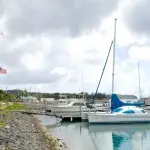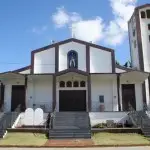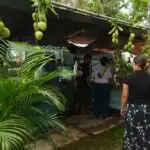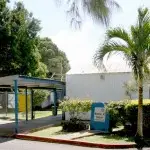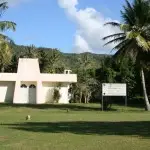Hågat/Agat
Table of Contents
Share This
Origin of village name in CHamoru
The village of Hågat may have been named by the first clan who came to settle in the area from the northern part of Guam. It is also possible that the village name Hagat originally was derived from the word Aga, which is the CHamoru name of the Marianas Crow – a large black bird that makes the sound “aga” while flying low over the jungle. The village’s name, too, could be derived from the CHamoru word håga, meaning blood.
Population
According to the US Census in 2010, the population of Hågat was 4,917.
Village officials
Kevin JT Susuico is the mayor of Hågat. Christopher J. Fejeran is the vice mayor.
Village description
While many regard Hågat as the western gateway to the south, it is also the commercial center of the south. Numerous businesses – from merchants and restaurants to the 61-room Inn on the Bay – have sprung up in the once-quiet seaside village in the last few decades. Along with Hågat’s thriving business center, the old heart of the village still exists, with Our Lady of Mount Carmel Catholic Church, Convent, and School.
The seaside village of Hågat lies just south of Naval Base Guam. The village’s main road, Route 2, meanders through several commercial and residential areas. The road also leads to a group of public buildings, such as the Hågat Community Center, mayor’s office, and post office. Farther south, Route 2 runs along the coast of some of the finest beaches on Guam, including Nimitz Beach. Nearby is the popular Hågat Marina. The village of Hågat is also home to several parks dedicated to the events of World War II. These parks are part of the National Park Service’s War in the Pacific National Historical Park.
Village history
It is believed that Chief Coroo headed the first clan of Hågat. Beloved by his people, he was also the eldest in the clan. Chief Coroo divided the village into families, each with its own surname. Many of these survive today but are referred to as CHamoru family names, such names as Koroo, Kamachili, De’chi, Dagu, Kusiu, Min, Ato, and Gotgohu, to name a few.
Spanish Governor Jose de Quiroga then designed Old Hågat between 1680 and 1684 as a settlement for rebellious islanders whose homes he had destroyed during the CHamoru rebellion. Many of its citizens were brought from the interior village of Fena. The first church in Hågat was established in late 1680. In the early 1700s, this church was one of only six parishes on Guam.
Pre-war Hågat was a small village with a coast lined with coconut trees that produced copra (coconut meat). The village also supported farming, ranching, and fishing. Rice paddies existed on the coastal flats as well as the flat inland areas.
Throughout the Japanese occupation from 1941 to 1944, new rice paddies were developed in Hågat to support the Japanese troops. Local people were forced into labor with little or no subsistence rations. Thirty days before landing on Guam on 11 June 1944, American air forces bombed the beaches of Hågat to clear Japanese positions. These bombings continued throughout June and July, destroying Japanese fortifications and virtually all of the structures of the village.
The beaches of Hågat and Asan were selected by the US forces for entry into the island, with two Marine Regimental Combat Teams and an Army Infantry Division landing at five points along the Hågat coast. They faced a 75 millimeter gun and a 37 millimeter gun mounted by the Japanese in a concrete blockhouse at Ga’an Point. In just the first day of the American invasion of Hågat beach on 21 July 455 Marines were killed and 536 were wounded. By nightfall, the Americans secured the Hågat beachhead, but were heavily assaulted by Japanese tanks that night. Heavy fighting ensued, and by the morning of July 22, the Americans had won the area and pressed onward toward Orote Point, eventually joining the forces that had landed in Asan.
After the Americans secured Hågat beach, they established a refugee camp for CHamorus freed from Japanese-made camps. At its peak, 18,000 people lived in the Hågat camp. Following the return of American forces, residents of Hågat lived in temporary houses before a new Hågat village was established at a location farther south. Both the military government and CHamorus built homes at the new site. In August 1978, the US National Park Service established the War in the Pacific National Historical Park on Guam, which included sites at the Hågat invasion beaches.
Points of interest
Village map
Institutions
Maria Rivera Aguigui Memorial Library
The Hågat public library was named after Maria Santos Rivera Aguigui in 2002 (Bill No. 349). Aguigui served forty years in the Guam Public School System in the villages of Hågat and Sumai. The library is open on Tuesday from 9 am to 5:30 pm with an hour lunch break.
Marcial A. Sablan Elementary School
Marcial A. Sablan Elementary consists of Kindergarten through fifth grades, and a Head Start program.
Oceanview Middle School
Oceanview Middle School was constructed in 1959 as Agat Junior High School. Later the school was modified into Oceanview High School, but has since reverted to a middle school.
Our Lady of Mount Carmel Catholic Church
Mt. Carmel was dedicated in 1937. It was rebuilt in its present location after World War II and is the center of village activities. A procession and village fiesta are held in July for the church’s patron saint, along with a procession for Santa Ana, the patron saint of Christian mothers. The village also holds another procession in honor of Santa Rosa.
Our Lady of Mount Carmel School
This Catholic school, located in the heart of Hågat, has pre-Kindergarten to eighth grade classes. In 2007, the threat of a closure loomed because of low enrollment rates, prompting the community and school alumni to rally in effort to keep the school open. Supporters coordinated events to raise funds and pushed for increased enrollment, which kept the school open.
St. Andrew’s By the Philippine Sea
This Episcopal church was constructed in the 1960s initially serving as a daycare center, but eventually became a parish.
Santa Ana Chapel
The Santa Ana Chapel was built in the 1950s and dedicated in 1968. In 2008, the Chapel was rebuilt by the Santa Ana Lancheros Association of Hågat. Currently the chapel is maintained by the Mount Carmel Church.
Southern Christian Academy
Southern Christian Academy offers courses from preschool to grade 12. The school’s curriculum was adapted from A-Beka, McDougal Littell, Association of Christian Schools International (ACSI), Harcourt Brace, and Pacific Region Educational Laboratory publications.
Historical
Hågat Beach Unit of the War in the Pacific National Historic Park
The Hågat Beach Unit of the War in the Pacific National Historic Park is one contiguous unit with four segments managed by the National Park Service. Two of these segments, Apaca and Ga’an Point, have visitor facilities including interpretive displays, picnic pavilions, barbecue grills, restrooms, and parking areas. Memorials and monuments have been added throughout the park.
Mount Alifan
This mountain rises 871 feet above the Hågat’s beaches and contains remains of the fighting between US and Japan’s armed forces at the end of WWII during the recapture of Guam. For the most part, the remains are craters, foxholes, emplacements, caves, and rifle-pits. Only two small features are constructed of concrete. Following capture of the mountain, American demolition teams sealed many caves on the forward slopes. The slopes contain many artifacts from the battle, including shell and bomb fragments and bullets.
Taleyfac and Taelayag Spanish bridges
These two stone bridges are reminders of Guam’s Spanish-colonial era. They are a couple of the few remaining bridges built using Spanish stone and mortar construction, and are listed on the Guam and National Registers of Historic Sites. The Taleyfac bridge, the more commonly known of the two, can still be seen just off the main road south of the main village, and was constructed by Governor Alexandro Parreño in 1785 over Talifac Creek (then called Muja Creek).
Recreational
Hågat Commercial Point Center
Located at the entrance of the village across Inn on the Bay, the Hågat Commercial Point Center houses restaurants and businesses for the southern community.
Hågat Sagan Bisita
The Hågat Sagan Bisita, next to the Mayor’s Office, is a series of pavilions lined around a courtyard with a large stage. This facility hosts the Tuesday Night Market from 3 pm to 8 pm, the Annual Hågat Mango Festival, and is available for reservations.
Hågat Small Boat Marina
The marina is a modern facility for docking small boats. The facility includes a sea rescue operation, restaurant and icehouse. The marina is a popular location for fishing derbies and daily charter fishing trips for local residents and tourists.
Hågat Senior Citizen Center
The Hågat Senior Citizen Center is located on Calle Delos Marteres Road and is a place where the man’amko in the village can go to to relax, play bingo, cards, or mahjong.
Hap’s Reef
Located just off Hågat Bay, Hap’s Reef is a popular site for divers and snorkelers to enjoy different marine life. Beachgoers can also spot pilot whales from this location.
Haya Youth Center
Haya is located between the Hågat Gymnasium and Hågat Senior Citizens Center. It holds various after school programs. In addition, Haya Youth Center hosts the Hågat Community Youth Summer Camp.
Inn on the Bay
A 61-room long-term apartment completed in 1989, Inn on the Bay offers fully furnished rooms. The facility also maintains a backup generator for emergencies. Inn on the Bay’s usual customers include military and navy contractors but welcomes all visitors.
Mango Festival
The village of Hågat held the first Hågat Mango Festival in May 2007 at Nimitz Beach. The annual event includes a canoe paddling race, displays, vendors booths, and a mango culinary competition. It is hosted by the Hågat Municipal Planning Council and partially funded by Guam Visitors Bureau.
Nimitz Beach
Located at the south edge of Hågat, Nimitz Beach is a popular public beach and recreational area with pavilions.
Village mayors/commissioners
- Kevin Susuico, Mayor, 2017-Present
- Carol S. Tayama, Mayor, 2005-2016
- Johnny M. Reyes, Mayor, 1997-2005
- Joaquin G. Topasna, Mayor, 10/1/96-01/06/97
- Antonio C. Babauta, Commissioner/Mayor, 1981-9/30/96
- Antonio R. Terlaje, Commissioner, 1977-1981
- Jose S. San Nicolas, Commissioner, 1973-1977
- Thomas FP Muña, Commissioner, 1965-1969
- Jose B. Guevara, Commissioner, 1963-1965
- Juan LG Leon Guerrero, Commissioner, 1956-1963
- Antonio P. Carbullido, Commissioner, 1945-1956
- Francisco C. Sablan, Commissioner, 1941-1944
- Francisco R. Chaco, Commissioner, 1937-1940
- Tomas C. Charfauros, Commissioner, 1934-1937
- Antonio P. Carbullido, Commissioner, 1930-1934
Vice mayors/assistant commissioners/deputy commissioners
- Christopher Fejeran, Vice Mayor, 2017-Present
- Agustin G. Quintanilla, Vice Mayor, acting December 2009. Officially elected into office November 2010.
- Jesus B. Chaco, Vice Mayor, 1997-2009
- Jessie S. Pendon, Vice Mayor, 10/01/96-01/06/97
- Joaquin G.Topasna, Vice Mayor, 1993-1996
- John A. Quidachay, Assistant Commissioner/Vice Mayor, 1989-1993
- Joseph R. Reyes, Assistant Commissioner, 1981-1988
- Antonio C. Babauta, Assistant Commissioner, 1977-1981
- Vicente Q. Guerrero, Assistant Commissioner, 1973-1977
- Jose S. San Nicolas, Assistant Commissioner, 1970-1973
- Vicente M. Salas, Deputy Commissioner, 1934-1937
- Pedro C. Charfauros, Deputy Commissioner, 1931-1933
- Jesus Carbullido, Deputy Commissioner, 1903-1908
- Jose Pineda, Deputy Commissioner, 1898-1903
Editor’s note: The preceding list was provided by Konsehelon Mahot Guåhan/the Mayor’s Council of Guam.
For further reading
Guam Department of Parks and Recreation. “Guam State Historic Preservation Office.”
Mayors Council of Guam. “MCOG – Mayors Council of Guam.”
Onedera, Peter R., ed. Nå’an Lugåt Siha gi ya Guåhan (Guam Place Names). Hagåtña: Chamorro Language Commission, 1988.
War in the Pacific NHP. “Cultural Resources Inventory (Table of Contents).” Last modified 3 May 2004.
Know my island - Know my history
The War in the Pacific National Historical Park
Ga’an Point, Hågat
The park ignited controversy in Hågat as it blocked a long-planned small boat harbor that was on the verge of construction at Ga’an Point. The US Department of Interior compelled the Government of Guam to move the harbor to a new site several miles away, near Nimitz Beach, by declaring a rusty old World War II sewer pipe at Ga’an Point to be a “historical landmark.” Lack of appropriated funding from Congress delayed completion of the park for years.

